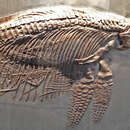en
names in breadcrumbs


Neodiapsida is a clade, or major branch, of the reptilian family tree, typically defined as including all diapsids apart from some early primitive types known as the araeoscelidians. Modern reptiles and birds belong to the neodiapsid subclade Sauria.
The oldest known neodiapsid is generally considered to be Orovenator from the Early Permian of North America, around 290 million years old.[1]
Basal-non saurian neodiaspids were ancestrally lizard-like, but basal non-saurian neodiapsids also include specialised swimming forms (Hovasaurus)[2] the gliding lizard-like Weigeltisauridae,[3] as well as the Triassic chameleon-like drepanosaurs.[4] The position of the highly derived Mesozoic marine reptile groups Thalattosauria, Ichthyosauromorpha and Sauropterygia within Neodiapsida is uncertain, and they may lie within Sauria.[5]
The clade Neodiapsida was given a phylogenetic definition by Laurin in 1991. He defined it as the branch-based clade containing all animals more closely related to "Younginiformes" (later, more specifically, emended to Youngina capensis) than to Petrolacosaurus.[6] The cladogram presented here illustrates the "family tree" of reptiles, and follows a simplified version of the relationships found by M.S. Lee, in 2013.[7] All genetic studies have supported the hypothesis that turtles are diapsid reptiles; some have placed turtles within archosauromorpha,[7][8] or, more commonly, as a sister group to extant archosaurs.[9][10][11][12] though a few have recovered turtles as lepidosauromorphs instead.[13] The cladogram below used a combination of genetic (molecular) and fossil (morphological) data to obtain its results.[7]
Diapsida Neodiapsida Sauria Lepidosauromorpha LepidosauriaRhynchocephalia (tuatara and their extinct relatives)![]()
Archosauriformes (crocodiles, birds, and their extinct relatives) ![]()
This second cladogram is based on the 2017 study by Pritchard and Nesbiit.[14]
Neodiapsida Sauria ArchosauromorphaThe following cladogram was found by Simões et al. (2022): [15]
Neoreptilia Neodiapsida Sauria LepidosauromorphaRhynchocephalia (tuatara and their extinct relatives)![]()
Pantestudines (turtles and extinct relatives)![]()
Archosauriformes (crocodiles, birds, and their extinct relatives) ![]()
Neodiapsida is a clade, or major branch, of the reptilian family tree, typically defined as including all diapsids apart from some early primitive types known as the araeoscelidians. Modern reptiles and birds belong to the neodiapsid subclade Sauria.
The oldest known neodiapsid is generally considered to be Orovenator from the Early Permian of North America, around 290 million years old.
Basal-non saurian neodiaspids were ancestrally lizard-like, but basal non-saurian neodiapsids also include specialised swimming forms (Hovasaurus) the gliding lizard-like Weigeltisauridae, as well as the Triassic chameleon-like drepanosaurs. The position of the highly derived Mesozoic marine reptile groups Thalattosauria, Ichthyosauromorpha and Sauropterygia within Neodiapsida is uncertain, and they may lie within Sauria.